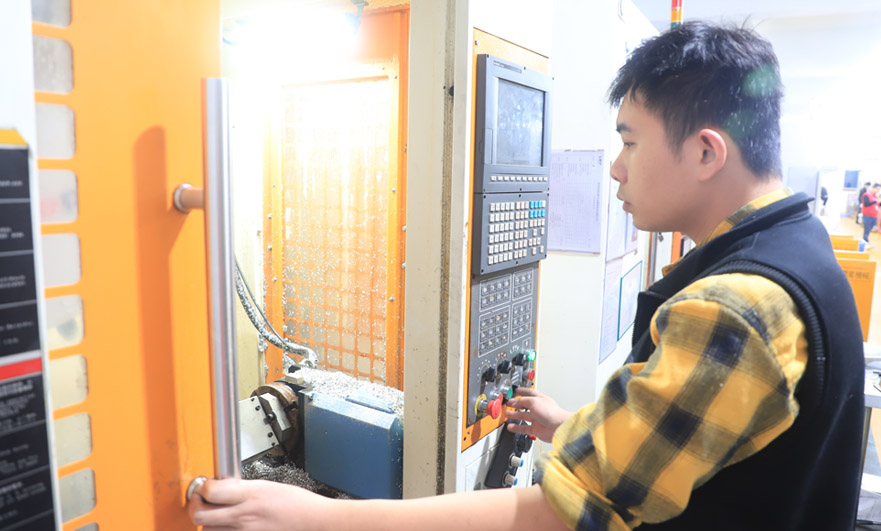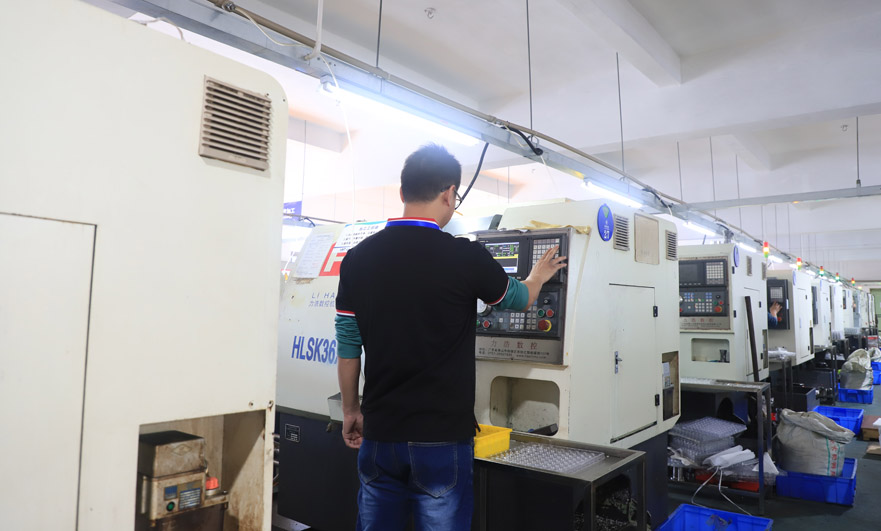When we begin to understand how to use CNC machining, we need to know what CNC is. The full name of CNC is “Computer numeric control”, which refers to computer numerical control precision machining, including CNC machining lathes, CNC machining boring and milling machines, and CNC machining milling machines etc.
It can actually refer to many processes, each of which uses different tools and machines to CNC machining manufacture the required parts. For example, CNC milling uses rotating tools and vertical motion to remove material from the surface of the workpiece, while CNC machining drilling allows engineers to make holes and shapes with precise diameters and lengths in the blank.

The working principle of CNC machining
After the workpiece is clamped in the machining center for the first time, CNC machining engineers use digital CAD files to assist in machine tool programming, effectively guide the tool movement, and can control the machine tool according to different CNC machining procedures, automatically select and replace tools, and automatically change the spindle speed and feed rate , Auxiliary functions such as the motion path of the tool relative to the workpiece, and complete the multi-process multi-process CNC machining of the workpiece in turn. And there are a variety of tool change or tool selection functions, so that the production efficiency is greatly improved.
Due to the concentration of processes and automatic tool change, the CNC machining center reduces the time for workpiece clamping, measurement and machine tool adjustment, so that the cutting time of the machine tool reaches about 80% of the machine start-up time (only 15-20% for ordinary machine tools); at the same time; It reduces the work piece turnover, handling and storage time between working procedures, shortens the production cycle, and has obvious economic effects.
The CNC machining center is suitable for small and medium batch CNC machining parts production CNC machining with complex milling parts, high precision requirements, and frequent product replacement. Compared with the vertical CNC machining center, the horizontal CNC machining center has a complicated structure, a large area, and a higher price. In addition, the horizontal CNC machining center is inconvenient to observe during processing, and the workpiece is inconvenient to clamp and measure, but it is easy to remove chips during processing, which is beneficial to CNC machining.
The working principle of CNC milling
The relative displacement of the CNC machining milling machine is programmed into the processing program table in a numerical control language, and then the program is input into the numerical control device, and the numerical control device controls the various operations of the machine tool and the relative displacement of the machine tool.
Tools and workpieces comply with CNC machining milling instructions. When the CNC machining milling parts program ends, the machine tool will automatically stop CNC machining milling qualified parts. The craft can be divided into production and craft. The production process is the whole process of converting raw materials into finished products.
The process is to change the shape, size, relative position and nature of the production object. The process of making it a finished or semi-finished product. When CNC machining parts on a CNC milling machine, all CNC machining processes are automatically completed by the machine except for manual loading and unloading of the workpiece.
In the flexible manufacturing system, loading and unloading, inspection, diagnosis, tool setting, transmission, scheduling, management and other tasks are also automatically completed by the machine tool.
The control information for automatic CNC machining on the CNC machine tool is the processing program. When the CNC machining object changes, in addition to changing the tool and solving the workpiece clamping method, as long as the processing program of the CNC machining part is rewritten and input, the new part can be automatically processed.
There is no need to make any complicated adjustments to the machine tool, shorten the production preparation cycle, and provide a shortcut for new product development, product improvement and modification.
The CNC machining milling machine has a high degree of automation, which can complete multiple surface CNC machining in one clamping, eliminating marking, multiple clamping, inspection, etc.; on the other hand, the CNC machining machine tool has high motion speed and short idle travel time.
Traditional lathes usually only allow CNC machining along two axes (the turning center may have some y-axis functions), while CNC machining lathes allow cutting operations along three, four, or five axes.
These additional operations include:
Straight or cylindrical turning: This process can be used to create a uniform cutting workpiece diameter and remove a large amount of material.
Taper CNC machining turning: Taper turning produces a cylindrical shape with a smoothly reduced diameter (similar to an hourglass shape).
Slotting: This process uses special-shaped tools to create narrow cavities in the workpiece.
Knurling: This technique involves cutting zigzag lines, angles or intersections on the workpiece to give the workpiece extra grip.
Thread: This produces the nuts and screws seen on the threads, which hold objects together and can accommodate relatively large or small geometries.
Parting: Parting is used to cut out the finished CNC machining part from the original workpiece.
CNC machining turning is usually very suitable for prototype and small batch CNC machining parts production. However, one factor that needs to be considered when determining whether CNC lathe turning is the most cost-effective CNC machining part production method is the outer diameter (OD) of the workpiece.
This is because the CNC lathe has the largest outer diameter to produce bar CNC machining parts. Any part whose outer diameter exceeds the set limit needs to be clamped separately, which may increase production CNC machining parts time and cost.
Another factor to keep in mind is the CNC machining tool itself. Many of them are cylindrical with limited cutting edges, which fundamentally determines how to cut the workpiece. This also means that design elements such as inner corners will have a radius, no matter how thin or small the tool size is.
CNC machining turning is very suitable for making undercut grooves (also called neck grooves or embossed grooves). These are common cylindrical CNC turning parts, which can be very troublesome to manufacture on a CNC milling machine. If you need to use specialized cutting tools, it is important to remember that these tools have their own challenges.
For example, a tool with a longer shaft helps to penetrate deep into the cavity of the workpiece—increasing the risk of vibration, poor cutting accuracy, and poor surface smoothness.

When to consider using CNC machining milling instead of CNC turning?
Although CNC turning provides unparalleled efficiency in producing parts with rotating contours, such as bolts, ball bearings, and washers, it is not the best choice for manufacturing non-axisymmetric parts.
CNC milling—usually used in automotive, aerospace, and furniture manufacturing applications, as well as the production of robotics and industrial machinery—can also be used with CNC turning to add design features, such as airplanes, which is impossible.
CNC milling of metal CNC machining parts
CNC milling machines use clamps or vises to hold the workpiece in place, while drills and cutters scrape off the material. It is highly configurable and provides product teams with greater flexibility in terms of CNC machining part geometry and complexity.
In summary
Understand the working principles of many different types of CNC machining machine tools, and select different machine tools for processing according to the accuracy and material characteristics of different CNC machining parts, so as to provide customers with higher dimensional accuracy and produce CNC machining parts with better mechanical properties.
What is CNC machining? If you want to know more, please come to our CNCMF official website for consultation. Of course, you can also send an email to our company’s mailbox for project consultation, and we will answer your questions online 24 hours a day. Looking forward to your next CNC machining project.